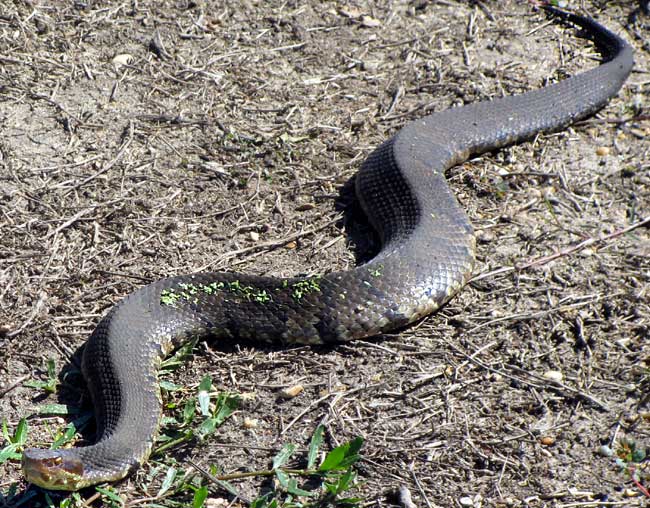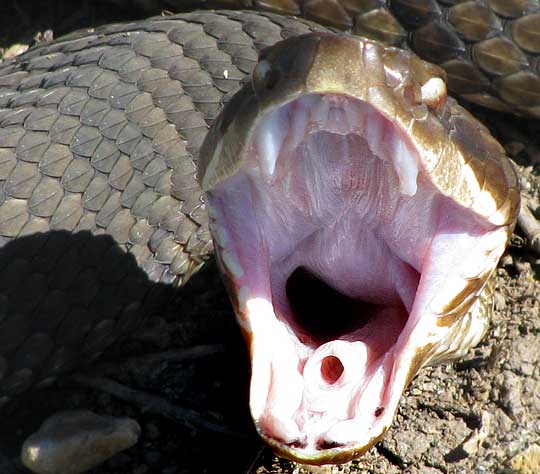Excerpts from Jim Conrad's
Naturalist Newsletter

from the October 25, 2009 Newsletter, from near Natchez, Mississippi
A COTTONMOUTH'S COTTONY MOUTH
Last Monday was such a pretty fall day that Karen and I couldn't stay away from St. Catherine Creek National Wildlife Refuge's 24,442 acres of swamps and seasonally flooded fields along the Mississippi River just south of Natchez. This summer Karen has fished a lot there so the first thing we did was to go see if the rising river had flooded her favorite fishing hole.
The water was indeed over many of the refuge's roads and her fishing spot was flooded. We had to turn around at a spot where a thick-bodied, blackish snake was sprawled out sunning himself. That's him above.
That's a venomous Cottonmouth or Water Moccasin, AGKISTRODON PISCIVORUS, common in swamps around here. The species is found throughout most of the US Southeast. Our snake was about 2-½ feet long and didn't seem at all concerned when I approached. The thick, black body, the head much wider than the slender neck, and the black mark behind the eye are about all you need to ID one of our Cottonmouths at a distance. Up close you also see a pit between the eye and nostril, which is a heat-sensing organ enabling the snake to locate prey in the dark, plus the eye's pupil is a vertical slit, like a cat's eye, instead of round. All of North America's poisonous snakes, including rattlesnakes and copperheads, are pit vipers with pits and vertical pupils, except for the coral snakes, which belong to a different family.
The green, confetti-like material on the snake's back is duckweed, indicating that the snake had just emerged from the water a few feet away. The species name "piscivorus" means "fish-eater" because Cottonmouths do catch and eat fish, their main fishing technique being cornering fish in shallow water. They also eat mammals, birds, amphibians, other snakes, small turtles and even small alligators.
You can see why Cottonmouths are called Cottonmouths below:

In that picture notice that between the two big fangs at the top of the mouth there's a pair of smaller ones forming. Also between the smaller ones there's yet another pair just beginning to take shape. Throughout any pit-viper's life new fangs always are being produced. On the average, fangs are replaced every sixty days or so. Though I've never seen it, I read that it's not unusual to find an old fang alongside a new one, a condition that lasts until the new fang is securely locked in place.
Also interesting in the picture is the tubelike affair at the bottom of the snake's mouth. That's the snake's breathing tube, or trachea. This design enables the snake to breathe while it's swallowing prey. Such breathing tubes are typical for snakes in general, not just pit vipers.
This picture also does a good job showing the Cottonmouth's "keeled scales." The keels are those slender little ridges running lengthwise down each scale. When you're identifying snakes with a field guide you're always being asked whether your unknown snake's scales are keeled or unkeeled because some snake groups have keeled scales and some don't. Cottonmouths have strongly keeled scales.
from the October 6, 2002 Newsletter, issued from near Natchez, Mississippi:
FISH-EATING COTTONMOUTH
During my Thursday morning rain-walk waiting for Lili I returned to the pond where I'd seen this week's otters. This time no otters were observed but a large Cottonmouth swam about ten feet from shore.
I see many Cottonmouths here but this one was doing something I've never beheld before, and I'll bet that it was because it was raining. Maybe it's a behavior usually practiced only at night.
The snake would swim a while, its head stiffly held from the water about 8 inches high (20 cm) and at about a 75° angle, flicking its tongue in and out, sniffing the air. Then it would thrust its head below the water's surface to about the same depth it had held it into the air, and sway the submerged head back and forth as it swam forward. He gave every impression of looking for fish, for in such deep water I doubt he could have snatched anything from the mud.
The Cottonmouth's Latin name is AGKISTRODON PISCIVORUS. That "piscivorus" means "fish-eater." My Audubon Reptile Field Guide says that Cottonmouths eat "sirens, frogs, fishes, snakes, and birds." I'm not sure about the sirens, but now it's easier to believe the fish part.
from the June 30, 2002 Newsletter, issued from near Natchez, Mississippi:
IGNORANCE BEGATS VIOLENCE
In the shadows beneath Black Willows at the edge of a pond dug for the deer deep in the forest I came upon a poisonous Western Cottonmouth, or Water Moccasin snake, AGKISTRODON PISCIVORUS LEUCOSTOMA. Its lay with its head resting atop a coil of its own thick, black body.
Usually I wouldn't have paid much attention but I could see that this particular snake was extremely dangerous. That's because he was about to molt. When a snake's molting time draws near, its outer skin starts separating from its new, inner one. The skin over the eyes also is molted, and there's a brief period when air gets between the old eye covering and the new one, causing the space to turn white. My cottonmouth's eyes were completely white because of this problem. He was practically blind.
The snake tensed, turning his head all around, but obviously he was unable to see where I was. Then suddenly like a spring being released, his coiled body shot into the air and there was a flash of whiteness as he stabbed where he thought I might be. Again and again he sprang, the white discharge of his open mouth for half a second vivid in the gloomy light.
I moved away thinking the snake might be overdoing it a bit. I'd never seen a serpent attack with such ferocity. But then I'd never seen a snake whose lenses were so completely opaque just before shedding. Maybe it's a law of nature that the less information you have, the more vulnerable you are, and therefore the more aggressive and violent you must be to stay alive. It's almost as if the snake were telling us that if we wish to reduce violence in our human society, we would do best to invest our monies in schools.
from the August 12, 2001 Newsletter, issued from near Natchez, Mississippi:
BIKING ADVENTURE
On Friday morning I was biking to the organic gardens, thinking only of my morning chores. Right before reaching the upper garden the dirt road passed through a narrow space between the tool shed and the giant bamboo patch. Because of recent rains water had pooled in the road's ruts, so I had to be careful to keep the bike from slipping into deep rut-water.
And then I realized that my bike's front tire had just run over the tail of an Agkistrodon piscivorus leucostoma - a Western Cottonmouth, also known as Water Moccasin. This is a very dangerous venomous snake.
My reflex was to slam on the brakes in order to keep the back tire from discomfiting the critter even more, but the moment I found myself balancing on a stationary bicycle with both legs spread out, and the snake below me stabbing at my wheels as its tail violently vibrated against dry leaves making it sound like a rattlesnake, I wondered if stopping had been the wise thing to do. Even under those circumstances I realized that eventually my bike would tilt one way or another, and that my legs would have to come down.
Fortunately it was a small snake, only about 30 inches long (75 cm) so when I finally had to bring my legs down I could spraddle them enough so that my feet didn't distract the snake's attention from my tires. I managed to inch my bike forward as the snake slipped into a rut's water, sending frogs jumping like popcorn.
I returned with a bucket, coaxed the snake into it, put a lid on it, and carried it to a lake across the hill.
Two white, immature Little Blue Herons awaited me at the lake, and since they were beyond a stone's-throw away they saw no reason to budge. Their reflections in the calm water were perfectly set among other reflections of blue sky, the green woods beyond, and graceful cattails bordering the lake. My snake swam into this reflected imagery, its head poked stiffly above the water and at the angle of an inverted V of waves spreading behind it. The effect was like that of a good Chinese-landscape watercolor, a perfect and wondrous story expressed with a very few brushstrokes.
One funny thing about the picture, however, was that my mostly-black snake appeared to be wearing oversized, buff-colored earmuffs. The "earmuffs" were the snake's large poison glands -- where its venom is produced. I've never seen a snake's poison glands so set off by color before, but in this particular individual the effect was striking. These glands are responsible for the superstition that snakes with triangular heads are poisonous. That's often the case, but not always, and lots of innocent and useful snakes are killed because of the error.
The herons eventually flew away as the snake approached them, and I was glad to have such a peaceful ending for what could have become a very painful, perhaps deadly, next few days.